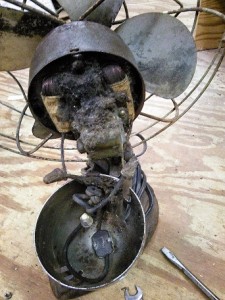Heather bought another old fan at the Arden Fair a few weeks back. It’s a single speed oscillating Eskimo with aluminum blades from the late 1930s. It has a somewhat attractive pseudo-Deco design with a spiderwebbish pattern to the cage.
Dissassembly revealed not only unbelievably thick crud deposits (half an inch of greasy fur inside the casing) but also the cheesiest design and materials I have ever seen in an antique fan.

The shaft bearings are thin and very yellow, very little copper content. But not all of the bearings are even metal! Some of them appear to be made of greased cardboard. The stator windings are literally bound with masking tape, although the wire nuts are porcelain. Two of the gears in the oscillator box are made of masonite – steam-pressed wood fiber. The worm gears they engage are steel, so don’t grab the fan and prevent it from oscillating unless you enjoy the sound of masonite gear teeth snapping off. The blade is soft aluminum, so soft that sticking a finger into the cage will almost certainly unbalance it… two of the blades are already bent, so that it vibrates noisily and the main shaft sidles erratically in and out like a trombone slide.
Even without the blade mounted it still sounds like a gravel crusher and the main shaft wobbles all over the place, because the squirrel cage rotor has never been balanced and all the cheesy bearing surfaces are worn out. If you push the oscillator shaft bearing up into the housing with a penknife it’ll swing back and forth wildly, at surprising speed, until the shaft bearing flys back out and the gearing disengages. I guess with a 2-pole stator and a 15-pole rotor you can’t expect smooth operation? The fact that the oscillator must have fallen apart almost immediately is probably what preserved those masonite gears.
Generous and repeated use of PB blaster, WD40, degreaser, and ultrasonics have given this piece of junk an interesting wabi-sabi patina that I kind of like, so I’m thinking about replacing all the bearing surfaces with bronze, and seeing if I can reshape the blade to restore balance. Planishing fan blades is always a big challenge, though.
